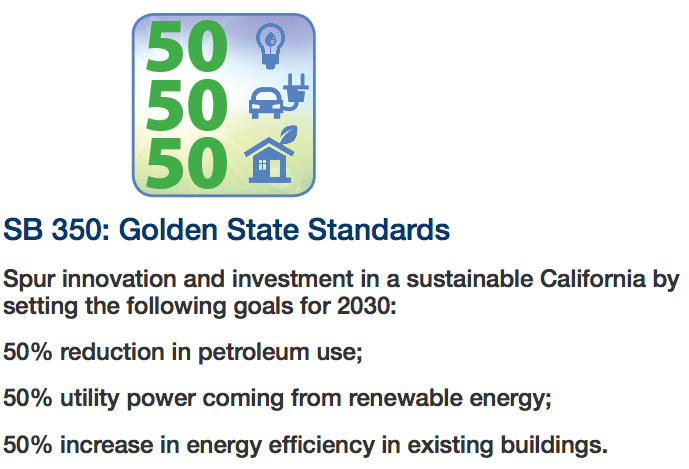
There's been a lot of media noise about ongoing efforts to pass new climate change legislation in California before the rapidly approaching deadline. One particular op-ed in the Orange County Register adds nothing useful to the debate, but as one of several efforts lately that have been working very hard to obscure facts, it deserves a wagging finger of shame.
The “contributing columnist,” one Ian Lamont, starts out by making the argument that S.B. 350, which seeks to set new energy reduction goals, and S.B. 32, which seeks to set new goals for greenhouse gas emission reductions, would repeat mistakes made by the California Global Warming Solutions Act of 2006. The writer claims that the 2006 law, A.B. 32, mandated “environmental goals without including any strategies on how to obtain them, or providing the funding in support.” Then, he writes, it made the mistake of giving “complete authority to achieve the 2020 goals, without any accountability or oversight, to a state agency, the California Air Resources Board [ARB].”
Some people may believe that our elected representatives should be the people who decide the specifics of scientific policy, whether that is their area of expertise or not. For others—me, for example--that doesn't sound like a great idea. Far preferable would be to set goals—in this case, of reducing greenhouse gas emissions by so much—and then leave the specifics on how to do that to a state agency chock full of experts in the field.
That's what A.B. 32 did. It set goals to reduce greenhouse gas emissions to 1990 levels by 2020, then called for the ARB to find a way to do that using “market-based mechanisms.” Which ARB then proceeded to do, within a whole panoply of policy work, including creating a brand new kind of market-based mechanism: the cap-and-trade system, which sets a cap on greenhouse gas emissions and charges industries for polluting.
It is a system, by the way, that was supported by industry consultants, including the fuels industry.
People are allowed to have opinions. The deeper problem with this piece is the way it plays fast and loose with facts, especially on the eve of an important vote that could help shape the future of this state. Whether he deliberately lied or was just too lazy to check the facts is irrelevant; either way the result is a highly irresponsible piece of writing.
The facts he got wrong are:
1) He claims that California's “legislative leadership in Sacramento and Governor Brown know that [the ARB] cannot achieve the 2020 goals.” On the contrary: those leaders must “know” the opposite is true, because ARB released a report this summer showing that the state is well on its way to achieving its A.B. 32 GHG reduction goals.
And ARB is not alone.
The Environmental Defense Fund has been tracking progress since cap-and-trade began, and finds the program is succeeding [PDF]. A separate analysis from Lawrence Berkeley Lab, published in Energy Policy, found that “not only will California meet its 2020 reduction goals under A.B. 32, but it could achieve reductions of at least 40 percent below that level in the 2030 time frame,” according to the study's author Jeffery Greenblatt, a scientist at the Department of Energy’s Lawrence Berkeley National Laboratory.
The science is far from perfect, because it's a field in its infancy. But the best estimates being made by experts who think about the subject all the time are that California's climate change policies are working.
2) He writes that, because California isn't going to meet its goals (see above), “the state Senate earlier this year passed Senate Bill 32 that not only reduced the 2020 goals but added 30 years to achieve them.”
Did he just forget that it's easy to find these bills online? S.B. 32 wouldn't reduce the earlier goals--quite the opposite. A.B. 32 set the goal of reaching 1990 greenhouse gas emission levels by 2020; S.B. 32 calls for reducing them to forty percent below 1990 levels by 2030 and to eighty percent below 1990 levels by 2050.
3) He claims that the cap-and-trade system “added an additional fifty cents to the cost of a gallon of gas and is one of the reasons Californians pay about $1 more per gallon than the rest of the country.”
Did he pull that figure out of a hat? It certainly didn't come from any of the published scientific analyses, which estimated that the effect on gas prices would be between ten and fifteen cents a gallon. Nor did the fifty-cent figure come from the paper that printed his editorial, the Orange County Register, which reported that, despite some early sky-is-falling estimates that prices would go up as much as 76 cents a gallon, “ARB, GasBuddy.com, and the Western States Petroleum Association estimate that cap-and-trade has raised gas prices about ten cents a gallon this year.”
And by the way, that amount was dwarfed by price fluctuations “in the aftermath of a February 18 explosion at the Exxon Mobil Corp refinery in Torrance [and the idling of Tesoro Corporation's] processing at its Martinez... plant earlier that month in response to a strike,” according to an LA Times article about legislative hearings into possible price fixing by the oil industry.
If the Orange County Register, and its writers, want to attack climate change policies, that's their prerogative. But making up stuff to argue their case serves no one.





